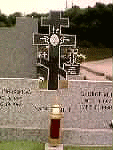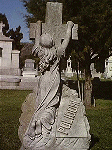<
 |
St. Andrew's Cross
Legend has it that when St. Andrew was martyred, he could not bear to be crucified upon the same cross upon which Christ died, so he requested that this shape be devised for his execution. |
 |
Celtic or Irish Cross
What you call this depends on whether you are Episcopalian (then it is Celtic) or Catholic (who call it the Irish cross). The cross is often used to mark the graves of priests and monks. |
 |
Crusader's Cross
The cross that led multitudes of Europeans into Holy War against the sometimes morally superior Muslims. Sometimes Christians followed it against other Christians, too! |
 |
Egyptian or Coptic Cross
Adapted by the Gnostics and the Copts from the ancient Egyptian symbol known as the ankh which symbolizes life. |
 |
Greek Cross
The four equal arms mark this symbol, taken by the International Red Cross as its official emblem. |
 |
Jerusalem Cross
Another crusader cross, associated with the Church of the Holy Sepulchre. |
 |
Orthodox, Patriarchal, or Eastern Cross
One of two crosses which attained its local popularity after the Great Schism between Eastern Orthodoxy and Roman Catholicism. The top cross bar represents the sign "Jesus Christ, King of the Jews", tacked there by the Romans. |
 |
Roman or Latin Cross
Another product of the Great Schism, this, like its Eastern counterpart seeks to recreate the actual form of the crucifix. |
 |
Teutonic Cross
The emblem adopted by the Teutonic Knights as they rampaged into Russia. A similar cross is that worn by the Knights of Malta, which has swallow-tailed arms. |















